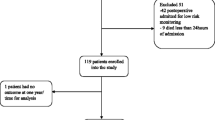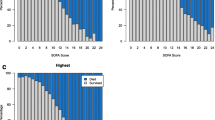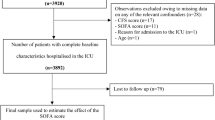Abstract
Objective: To evaluate the use of the Sequential Organ Failure Assessment (SOFA) score, the total maximum SOFA (TMS) score, and a derived variable, the ΔSOFA (TMS score minus total SOFA score on day 1) in medical, cardiovascular patients as a means for describing the incidence and severity of organ dysfunction and the prognostic value regarding outcome. Design: Prospective, clinical study. Setting: Medical intensive care unit in a university hospital. Patients: A total of 303 consecutive patients were included (216 men, 87 women; mean age 62 ± 12.6 years; SAPS II 26.2 ± 12.7). They were evaluated 24 h after admission and thereafter every 24 h until ICU discharge or death between November 1997 and March 1998. Readmissions and patients with an ICU stay shorter than 12 h were excluded. Main outcome measure: Survival status at hospital discharge, incidence of organ dysfunction/failure. Interventions: Collection of clinical and demographic data and raw data for the computation of the SOFA score every 24 h until ICU discharge. Measurements and main results: Length of ICU stay was 3.7 ± 4.7 days. ICU mortality was 8.3 % and hospital mortality 14.5 %. Nonsurvivors had a higher total SOFA score on day 1 (5.9 ± 3.7 vs. 1.9 ± 2.3, p < 0.001) and thereafter until day 8. High SOFA scores for any organ system and increasing number of organ failures (SOFA score ≥ 3) were associated with increased mortality. Cardiovascular and neurological systems (day 1) were related to outcome and cardiovascular and respiratory systems, and admission from another ICU to length of ICU stay. TMS score was higher in nonsurvivors (1.76 ± 2.55 vs. 0.58 ± 1.39, p < 0.01), and ΔSOFA/total SOFA on day 1 was independently related to outcome. The area under the receiver-operating characteristic curve was 0.86 for TMS, 0.82 for SOFA on day 1, and 0.77 for SAPS II. Conclusions: The SOFA, TMS, and ΔSOFA scores provide the clinician with important information on degree and progression of organ dysfunction in medical, cardiovascular patients. On day 1 both SOFA score and TMS score had a better prognostic value than SAPS II score. The model is closely related to outcome and identifies patients who are at increased risk for prolonged ICU stay.
Similar content being viewed by others
Author information
Authors and Affiliations
Additional information
Received: 6 August 1999 Final revision received: 3 January 2000 Accepted: 28 March 2000
Rights and permissions
About this article
Cite this article
Janssens, U., Graf, C., Graf, J. et al. Evaluation of the SOFA score: a single-center experience of a medical intensive care unit in 303 consecutive patients with predominantly cardiovascular disorders. Intensive Care Med 26, 1037–1045 (2000). https://doi.org/10.1007/s001340051316
Issue Date:
DOI: https://doi.org/10.1007/s001340051316




